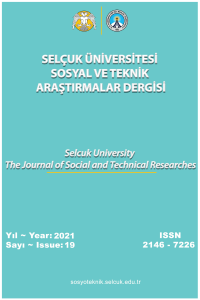I-V Characteristics Calculation Using SCAPS-1D Program SCAPS-1D Programı Kullanılarak I-V Karakteristiklerinin Hesaplanması
I-V Characteristics Calculation Using SCAPS-1D Program
SCAPS_1D, Solar Cells, Thin Films, CIGS,
___
- [1] D. M. Chapin, C. S. Fuller, and G. L. Pearson, "A new silicon p‐n junction photocell for converting solar radiation into electrical power," Journal of Applied Physics, vol. 25, no. 5, pp. 676-677, 1954.
- [2] L. M. Fraas and L. D. Partain, Solar cells and their applications. John Wiley & Sons, 2010.
- [3] S. Zandi, P. Saxena, and N. E. Gorji, "Numerical simulation of heat distribution in RGO-contacted perovskite solar cells using COMSOL," Solar Energy, vol. 197, pp. 105-110, 2020.
- [4] A. Hima, N. Lakhdar, B. Benhaoua, A. Saadoune, I. Kemerchou, and F. Rogti, "An optimized perovskite solar cell designs for high conversion efficiency," Superlattices and Microstructures, vol. 129, pp. 240-246, 2019.
- [5] Y. Hamri et al., "Improved efficiency of Cu (In, Ga) Se2 thinfilm solar cells using a buffer layer alternative to CdS," Solar Energy, vol. 178, pp. 150-156, 2019.
- [6] A. Bag, R. Radhakrishnan, R. Nekovei, and R. Jeyakumar, "Effect of absorber layer, hole transport layer thicknesses, and its doping density on the performance of perovskite solar cells by device simulation," Solar Energy, vol. 196, pp. 177-182, 2020.
- [7] A. Houimi, S. Y. Gezgin, B. Mercimek, and H. Ş. Kılıç, "Numerical analysis of CZTS/n-Si solar cells using SCAPS-1D. A comparative study between experimental and calculated outputs," Optical Materials, vol. 121, p. 111544, 2021.
- [8] J. Wang et al., "Simple Solution‐Processed Approach for Nanoscale Coverage of Perovskite on Textured Silicon Surface Enabling Highly Efficient Perovskite/Si Tandem Solar Cells," Energy Technology, vol. 9, no. 1, p. 2000778, 2021.
- [9] M. A. Ashraf and I. Alam, "Numerical simulation of CIGS, CISSe and CZTS-based solar cells with In2S3 as buffer layer and Au as back contact using SCAPS 1D," Engineering Research Express, vol. 2, no. 3, p. 035015, 2020.
- [10] D. Dwivedi, "Numerical simulation for enhancement of the output performance of CZTS based thin film photovoltaic cell," Advanced Science, Engineering and Medicine, vol. 12, no. 1, pp. 88-94, 2020.
- [11] H. Shen et al., "Monolithic perovskite/Si tandem solar cells: pathways to over 30% efficiency," Advanced Energy Materials, vol. 10, no. 13, p. 1902840, 2020.
- [12] S. Tripathi, P. Lohia, and D. Dwivedi, "Contribution to sustainable and environmental friendly non-toxic CZTS solar cell with an innovative hybrid buffer layer," Solar Energy, vol. 204, pp. 748-760, 2020.
- [13] M. Burgelman, K. Decock, A. Niemegeers, J. Verschraegen, and S. Degrave, "SCAPS manual," ed: February, 2016.
- [14] M. Burgelman, K. Decock, S. Khelifi, and A. Abass, "Advanced electrical simulation of thin film solar cells," Thin Solid Films, vol. 535, pp. 296-301, 2013.
- [15] J. Jiang et al., "Optimization bandgap gradation structure simulation of Cu2Sn1− xGexS3 solar cells by SCAPS," Solar Energy, vol. 194, pp. 986-994, 2019.
- Başlangıç: 2011
- Yayıncı: Selçuk Üniversitesi
Modern Yönetimin Adı: Toplam Kalite Yönetimi
Pazarlamada ‘Marka Aşkı’ Kavramının Bibliyometrik Analizi: Çalışmalar ve Eğilimler
Pandemi Döneminde Çalışan Anne Olmak: Metaforlar Üzerinden Bir Değerlendirme
Kurumsal Sosyal Sorumluluk Faaliyetlerinin Marka Sadakatine Etkisi
Geçmişten Günümüze Portföy Yönetiminde Neler Değişti? R Programı ile Bibliyometrik Analiz
İnsan Hakları Hukuku Açısından Kadına Şiddet
Abdülazim İBRAHİM, Asiye Nurşen DAĞ
Amina HOUIMI, Serap YİĞİT GEZGİN, Yasemin GÜNDOĞDU, Hamdi Şükür KILIÇ
